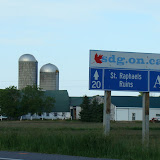“Oh ye tak the high road, and I’ll tak the low road, and I’ll be in Scotland afore ye, for me and my true love will never meet again on the bonnie bonnie banks of Loch Lomond.” (Steven McDonald, CD “Sons of Somerled” and “Stone of Destiny”) Mr. McDonald and are displaced Scots.
St. Raphael’s is surreal. I walked the ruins and the cemetery and visited twice to make sure it will always be a part of my memory. I approached the ruins from both directions. My first visit was going west and all of a sudden you come out of the trees and there it is before you. Following the road from the east you see what the photograph below shows you.
The website for the ruins is filled with interesting information about the history of the site, photographs of the ruins being used for events, how to give or become a member, music and more. Take a moment or two to study it before you look at my photographs.
http://www.saintraphaelsruins.com/
My first visit I turned left off of Hwy #34 and headed west on Hwy #18. The second visit was up Brookdale in Cornwall to Hwy #138 and turned right onto Hwy #18 at St. Andrews West. Hwy #18 is very nice going east to west and you can go through St. Andrews West, drive through Martintown and come to St. Raphael’s and then to Hwy #34 which can take you north to south. Along the way you can turn down Hwy #19 to Williamstown. It is a beautiful drive to St. Raphael’s along Hwy #18.
When you first see St. Raphael’s, from the west, you are stunned by its stately manner. St. Raphael is on a ridge, at least that was my feeling. There is a U-shaped driveway in front of the ruins so you can park easily.
You cannot get it all in your photograph so you have to try various angles.
I was so fortunate, both days I visited it was warm and sunny.
This man in a truck parked and went into the interior of the ruins. I waited till he had his turn before I entered.
Once he had finished his visit, I entered from the front.
I felt like I should whisper but instead I gently sang “Loch Lomond.”
A very nice video of the song and lyrics is presented here: http://www.youtube.com/watch?v=rbb9aRSQpsY
The other song was “Auld Lang Syne.” Forgive me, but you must have some music when you visit.
To document my visit to St. Raphael’s I took a timed picture of me in the front of the church.
This is the functioning part of St. Raphael’s and the present part of the Parish of St. Raphael’s.
There are many plaques out in front one of which is commemorating the Glengarry Immigration:
A plaque in both English and French sharing information about Bishop Alexander Macdonell 1762-1840. It is on the brick pillar right in front of the church ruins.
The plaque that features a brief history of the ruins. There is a photograph of the church before the fire in the book: Stormont, Dundas and Glengarry A History, by John G. Harkness on page 126 and a picture of the Bishop.
This plaque is attached to the walls of the ruins and one is in French and the other in English:
The cemetery wraps around St. Raphael’s dominating the area behind the church.
The cemetery is also on the left side as you face the front of the church.
From the east looking west the cemetery spills down the hill much farther than I had expected or noticed on my first visit to the ruins.
The welcoming sign of St. Raphael’s Parish and the cattle who were lowing as I visited.
Remember to click on the photograph and it will open up in a bigger window. Then click your back button to return to this blog. I will upload more photos from my visit when I finish posting for this trip.
UPDATE 07/09/2012: The link below includes additional photographs of the ruins and the area around it. These are overview photographs.
UPDATE: August 9, 2023: Picasa and Album Archive are no longer showing my photos. I may come back and fix that in the future.
 |
| St. Raphael’s Ruins & Cemetery |



















Looking for a Alexander MacDonald born Scotland 1826 resided Glengarry Co. in Ont the 1840’s then Haldimand co. He died in Dunnville Ontario
LikeLike
Betty: Thanks for stopping by. It is very difficult to pin down MacD’s. This particular Alexander does not seem familiar to me. To run searches on my blog put his name into the search box on the right side of the blog and see what comes up. Dunnville, is over near the Niagara Peninsula where a lot of Loyalist settled. They moved around a lot more than you think. Good luck. Bonnie
LikeLike